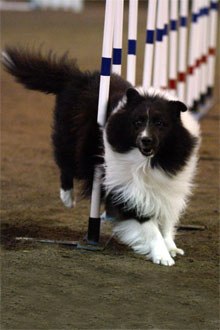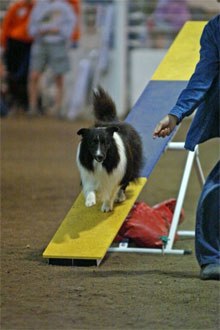Greater St. Louis
Shetland Sheepdog Club

Greater St. Louis
Shetland Sheepdog Club








THE SPORT, IN A NUTSHELL
Agility provides the chance for the dog and the handler to work as a team as the team navigates its way through various obstacles. These obstacles include contact equipment such as a dog walk, A-frame, teeter, and table. Other obstacles are open tunnels, closed tunnels (chute) and jumps including single bar, double, triple, tire, and broad jumps, and weave poles.
A person can compete in competitive trials or just plan to have fun at home with agility. Weekly training classes are recommended for the dog and the handler who is contemplating engaging in competitive trials.




THE OBJECT OF THE GAME
A dog’s height will need to be officially measured prior to competing in order to obtain an official AKC Jump Height Card. This will enable the dog to be entered in the right jump height category, i.e., 8, 12, 16, or 20 inches for shelties. There is a preferred level as well where a dog can jump one height lower than their actual height. This level also provides 5 additional seconds on the course time. Entering preferred classes may be advisable for beginners with a slower dog or is especially targeted for older dogs to allow them to still run agility but at a lower jump height.
When first competing, the team will enter the novice level at the appropriate jump height. At the novice level, there are 13 to15 obstacles in a course. The course generally requires the dog to perform the obstacles with minimal handling techniques. After a dog completes the novice level by obtaining three qualifying legs in the class, the dog competes at the open level. The open level has 16 to 18 obstacles. The course requires more difficulty obstacle course performance with more handling skills required. After obtaining three qualifying open legs, the dog moves to the Excellent level. At the excellent level, there are 18 to 20 obstacles. The courses require a clean efficient run in a very challenging course. After three qualifying excellent A legs, the dog moves on to Excellent B class where the dog can work on earning the Master Agility Champion (MACH) title.


HOW TO KNOW IF YOU AND YOUR DOG WOULD MAKE A GOOD TEAM
The key to agility is to have the right dog with the proper structure and temperament. The best dog candidates have a confident temperament. If the dog will take food from a stranger outside of their normal environment, that is a good sign.
Also, the closer the dog is conformational to the ideal structure, the better (please see the AKC breed standard for Shelties). It will ensure that the dog will be able to jump and also climb the various obstacles. It will also help to ensure that the dog's agility career will be a long one where you could be competing even when 12 to 13 years of age.
Agility is a sport that almost anyone can do. The dog and the handler will develop as a team. Even if the handler is not agile nor fast, the handler and team can learn to work together to be successful. However, patience is required. It takes 2 to 3 years of training for the team to really click.
Agility also requires your commitment to training with your dog. You can start training with a puppy as early as 8 weeks old. At that time you can start teaching basic attention and obedience skills such as sit, stay and down. At six months old, you can enroll your dog in a beginning agility class where the dog will be introduced to all the agility equipment. Afterwards you can advance to further agility classes where you will learn handling skills and the dog will continue to navigate the equipment and course. A dog can enter their first competitive AKC trial after 15 months of age. It actually takes at least a full year of training before you are ready to enter a trial.




HOW TO GET STARTED
If you think you have a dog that potentially has the right stuff to be successful in agility, then you should contact a local trainer about beginning classes. In the St Louis region, there are three AKC agility clubs including the Gateway Agility Club, Greater St Louis Agility Club and the Tri-county Agility club. It is also recommended that you attend a local agility trial. There are numerous trials in the greater St Louis area. The AKC website (www.akc.org) can provide information about trials and other details about the regulations for the sport.



Fireside On The Go


CH MACH Saranac Bi Chance, CD, HT, OF
Fireside On The Go
CH MACH Saranac Bi Chance, CD, HT, OF
Fireside On The Go